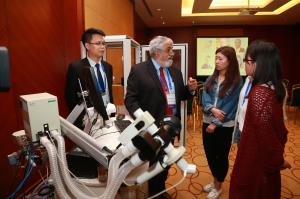Beyond regulation—Treating respiratory illness in China, one doctor at a time
By: Barbara Phillips, MD, MPH, FCCP, President of the American College of Chest Physicians
May 12, 2016
We’ve all seen it—photos of school children in China wearing face masks on high air pollution days. China’s pollution appears in newsfeeds throughout the world. The focus has been on regulation and prevention of air pollution in China, but little attention has been paid to the planning and infrastructure in place to provide the needed care to the 1.357 billion people living in China. The World Health Organization reports  that chronic respiratory diseases are the second leading cause of death in China. Rates of childhood asthma have also grown, and research has found that parents have little understanding or knowledge of asthma, which directly impacts the care those with asthma may receive. Chinese officials estimate that air pollution claims up to 500,000 lives each year. How is the respiratory health crisis in China being addressed?
that chronic respiratory diseases are the second leading cause of death in China. Rates of childhood asthma have also grown, and research has found that parents have little understanding or knowledge of asthma, which directly impacts the care those with asthma may receive. Chinese officials estimate that air pollution claims up to 500,000 lives each year. How is the respiratory health crisis in China being addressed?
 The American College of Chest Physicians (CHEST) has been working on the ground in China for nearly five years to prepare physicians for the country’s first-ever medical subspecialty in the area of pulmonary and critical care medicine. This training will equip clinicians in China to provide care to those impacted by devastating, sometimes chronic, respiratory and critical illness such as COPD, lung cancer and asthma brought on by pollution and air quality issues.
The American College of Chest Physicians (CHEST) has been working on the ground in China for nearly five years to prepare physicians for the country’s first-ever medical subspecialty in the area of pulmonary and critical care medicine. This training will equip clinicians in China to provide care to those impacted by devastating, sometimes chronic, respiratory and critical illness such as COPD, lung cancer and asthma brought on by pollution and air quality issues.
CHEST has worked with government officials in China to designate 12 clinician-training sites for formal pulmonary and critical care subspecialty training. The first class of graduates will complete training in late 2016. CHEST has a formal partnership with both the Chinese Thoracic Society and the Chinese Association of Chest Physicians to continue advancing these efforts.
Just last month we held CHEST World Congress in Shanghai. The educational event drew more than 2,000 attendees and offered hands-on training, cutting-edge research and world-renowned experts—right at the fingertips of Chinese clinicians. Last fall, CHEST hosted Chinese officials and program training directors from the China-CHEST Pulmonary Critical Care Medicine program at CHEST 2015 in Montréal, and a similar group plans to attend the CHEST 2016 Annual Meeting in Los Angeles—a meeting drawing chest clinicians from around the globe.
 Also last year, we partnered to provide the first Sino-American Respiratory Medicine Forum on COPD, held in Beijing. COPD is a leading cause of morbidity and mortality in China with tobacco smoking, biomass fuel use and genetic susceptibility being the major risk factors. COPD poses a high economic burden with the total expenditure per patient costing up to 40 percent of an average Chinese family’s income.
Also last year, we partnered to provide the first Sino-American Respiratory Medicine Forum on COPD, held in Beijing. COPD is a leading cause of morbidity and mortality in China with tobacco smoking, biomass fuel use and genetic susceptibility being the major risk factors. COPD poses a high economic burden with the total expenditure per patient costing up to 40 percent of an average Chinese family’s income.
In addition to formal education and the formation of subspecialty training in pulmonary and critical care medicine, the CHEST Foundation has awarded humanitarian grants to projects focused on training clinicians in pulmonary and critical care medicine in remote areas of China, providing much-needed care and resources to those who need it most.
We’re working to provide essential tools to both clinicians working in major hospitals in Beijing and those on the front lines practicing in remote clinics in rural China. CHEST’s commitment to providing education, training and partnership to improve the quality of life and quality of care in China is unwavering.
How can you help? Start by spreading the word in your own network to build awareness of this pending health crisis in the world’s most populous nation, and of CHEST’s efforts, in collaboration with Chinese Association of Chest Physicians and the Chinese Thoracic Society, to help combat it. This is a global problem that we can only solve with the efforts of clinicians and health care professionals across many nations. The conversation on how to move forward starts now.